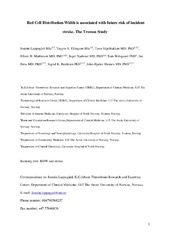Red cell distribution width is associated with future risk of incident stroke. The Tromsø study
Permanent lenke
https://hdl.handle.net/10037/9055Dato
2015-08-20Type
Journal articleTidsskriftartikkel
Peer reviewed
Forfatter
Lappegård, Jostein; Ellingsen, Trygve; Skjelbakken, Tove; Mathiesen, Ellisiv B.; Njølstad, Inger; Wilsgaard, Tom; Brox, Jan; Brækkan, Sigrid Kufaas; Hansen, John-BjarneSammendrag
Red cell distribution width (RDW), a measure of the variability in size
of the circulating erythrocytes, is associated with cardiovascular morbidity
and mortality. We aimed to investigate whether RDW was associated
with incident stroke and case fatality in subjects recruited
from the general population. Baseline characteristics were obtained
from 25,992 subjects participating in the fourth survey of the Tromsø
Study, conducted in 1994/95. Incident stroke was registered from inclusion
until December 31, 2010. Cox regression models were used to
calculate hazard ratios (HR) with 95 % confidence intervals (95 % CI)
for stroke, adjusted for age, sex, body mass index, smoking, haemoglobin
level, white blood cell count, thrombocyte count, hypertension,
total cholesterol, triglycerides, self-reported diabetes, and red blood
cell count. During a median follow-up of 15.8 years, 1152 participants
experienced a first-ever stroke. A 1 % increment in RDW yielded a
13 % higher risk of stroke (multivariable HR: 1.13, 95 % CI:
1.07–1.20). Subjects with RDW in the highest quintile compared to
the lowest had a 37 % higher risk of stroke in multivariable analysis
(HR: 1.37, 95 % CI: 1.11–1.69). Subjects with RDW above the 95-percentile
had 55 % higher risk of stroke compared to those in the lowest
quintile (HR: 1.55, 95 % CI: 1.16–2.06). All risk estimates remained unchanged
after exclusion of subjects with anaemia (n=1102). RDW was
not associated with increased risk of death within one year or during
the entire follow-up after an incident stroke. RDW is associated with
incident stroke in a general population, independent of anaemia and
traditional atherosclerotic risk factors.
Beskrivelse
Accepted manuscript version. This article is not an exact copy of the original published article in Thrombosis and Haemostasis. The definitive publisher-authenticated version of “Red cell distribution width is associated with future risk of incident stroke. The Tromsø study" is available online at http://doi.org/10.1160/TH15-03-0234.


 English
English norsk
norsk